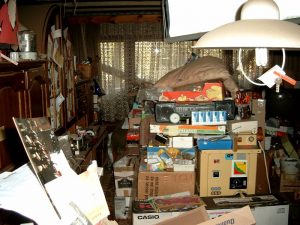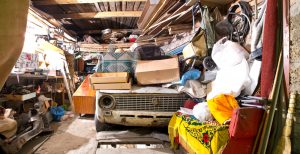Did you know that up to 1 in 20 of the elderly have tendencies that are consistent with hoarding? Scientists call the combination of self-neglect, extreme hoarding, squalor, and a lack of shame “Diogenes syndrome,” though it’s often a complete mystery to caregivers and others. At the end of the article, we’ll explain why “Diogenes” is a bit of a misnomer, but for now, let’s dive into the uncomfortable world of hoarding.
It’s understandable for older relatives to be a bit eccentric or reclusive, but at what point do their behaviors become pathological? Patterns of excessive hoarding and self-neglect in the elderly can be painful to witness, and even harder to remedy when you’re dealing with a stubborn person.
The many symptoms of elderly hoarding and squalor aren’t pretty to think about, and they’re even less pretty to deal with first hand. Often, elderly hoarders only reach out for help when they’re at the end of their wits– and unfortunately, the end of their lives. Hoarding and living in squalor are both broadly dangerous and detrimental to anyone’s health, never mind the weakened health of a mentally ill senior.
In this article, we’ll teach you about the syndrome, senile squalor syndrome, hoarding, and what to watch out for in the senior citizens that you love. At the end of the article, we’ll offer a few potential solutions and treatments to the syndrome and squalor syndrome.
What Is Senile Squalor Syndrome?
Senile squalor syndrome is a pathological condition in which seniors can no longer take care of themselves or their homes, resulting in the buildup of messes, objects, and decay. It’s common for the homes of seniors with the syndrome to be laden with piles of rotting food, peeling wallpaper, and even dead pets trapped beneath hills of debris that a well-functioning person would have never let accumulate.
Squalor gets mentioned in the same breath as hoarding disorders very frequently. Squalor syndrome occurs for several similar reasons which may surprise you. First, frontal lobe damage or degeneration from dementia are core to senile squalor.
The frontal lobe of the brain is responsible for executive functioning, which includes long-term planning, motivation, task saliency, and also short-term planning of action. In senile people, connections between the frontal lobes executive functions and the rest of the brain have likely weakened after a lifetime of use. Weakened communication between the frontal lobes and the rest of the brain means that certain norms aren’t worth following in the eye of the senior.
Impacts to the senior’s physical mobility often play a role in the development of senior squalor syndrome. The more physical work a senior believes the task of cleaning up or picking up will require, the larger of a motivational barrier they build in their minds. Once this imagined task of cleaning or picking up becomes too big to deal with, the thought is suppressed, or action of picking up is procrastinated to a later time.
Planning to perform actions, like cleaning up or picking up, is extremely difficult with a degraded frontal lobe. The seat of working memory is also in the frontal lobe, which means that even tenuously created plans to clean up are at high risk of being forgotten and falling by the wayside. Thus, squalor develops via a combination of reduced physical ability, accumulated brain damage, and lack of a sufficient support network to assist with everyday tasks.
So long as a senior citizen is living in a context where they still have the ability and the agency to maintain their environment, they should be safe from squalor. As they age, the probability becomes more and more likely because of weakening physical ability and also weakening mental prowess.
Risk Factors
The risk factors for squalor may surprise you. In the previous section, we mentioned frontal lobe degeneration or damage. Prior brain damage during earlier in a senior’s life makes them have a higher risk of developing a hoarding syndrome. Likewise, if a senior was diagnosed with depression or obsessive-compulsive disorder earlier in life, they have a much higher chance of developing a hoarding disorder in their twilight years.
There is an abundance of natural aging processes which result in frontal lobe degeneration, but for senile people prone to hoarding and living in squalor, there are other factors at play, too. It takes more than old age to turn someone into a full-blown hoarder, willing to live in total squalor.
Seniors suffering from hoarding or squalor typically live alone and are at increased risk of depression, which causes further damage to the frontal lobe’s ability to regulate the rest of the brain. In short, being reclusive and lonely causes brain damage.
This fact means that the seniors that are at the highest risk of developing a hoarding disorder are those who are isolated and vulnerable. On top of the negative health effects of isolation, isolation also enables many of the behaviors that characterize senior hoarders. Housemates and relatives are seldom okay with living in filth, and in their presence act as a barrier against the development of full-blown hoarding.
Prior emotional trauma involving loss also puts seniors at a higher risk for hoarding and squalor, as does a history of generosity. This can lead to heartbreaking interactions between hoarders and their relatives in which the hoarders attempt to offer their seemingly precious items to the relatives, who are revolted.
The hoarders simply don’t see squalor due to deficits in their working memory or other frontal lobe features. It’s critical to stay compassionate, even when the elderly lash out as a result of their confusion—they simply can’t control themselves.
Signs And Symptoms Of Elderly Hoarding

Hoarders syndrome starts off in a way that may seem innocent: retaining objects for sentimental reasons. Everyone is entitled to have personal possessions, and keeping things around for their sentimental value is also something that everyone has a right to do.
The difference is that hoarders attach sentimental meaning to every object, and can never stand to part with something that could, in some fantastical situation, come in handy.
Seniors can likely articulate these fantastical reasons for any given object if prompted. The key to understanding the rationale behind each object is that the senile individual’s perspective of what items are worth keeping and which are not is severely skewed. There will be a rationale for every object, no matter how trivial disposal may seem.
To a normal person, these rationales will be overtly false, but to an elderly hoarder, they ring true. The very perception of reality of an elderly hoarder is extremely compromised. Even coming to terms about what behaviors are damaging to their health can be hard when it comes to talking about cleanliness and object retainment.
The biggest single test for elderly hoarding is to prompt the hoarder to discard an object that has no sentimental or utilitarian value. In many cases, it could be rotting food, wrapping paper, or broken dishes. The hoarder will reject the call to discard the useless objects, inventing a rationale. The rationale will seem completely off-base to a rational observer, indicating that the senior is in deep trouble.
Diogenes Syndrome Prognosis And Treatment Options
There are a few tactics for treating senior hoarding and squalor. The most effective tactic is to remove the senior from the conditions of squalor and place them into a supervised living facility. Though the senior will likely resist this separation from their objects, squalor and hoarding are always accompanied by a general inability to take care of oneself.
This means that the senior belongs in a place where others can help them to maintain a decent standard of living which they couldn’t on their own. It is not recommended to move a relative with hoarder syndrome into your home for care.

Seniors who hoard and live in squalor are beyond the level of care that most people can provide at home, and will likely experience a big drop in their quality of life as a result.
There are also several combined pharmacological and psychological interventions, formulated from protocols for obsessive-compulsive disorder. These interventions are unlikely to work because they depend on the senior to take the medication that they are prescribed consistently while also implementing lifestyle changes with the help of a therapist.
The medications required for this approach may also have adverse drug interactions with other medications that the senior is taking or should be taking, which can cause medical problems. If hoarding a habit in a senior, the most common treatment regimen as outlined above is likely to be ineffective.
Critically, any attempts to generate change within the hoarder will resist. Resistance gets stronger for senile persons with dementia, who may become confused and more agitated. Sneaky techniques are ethically questionable, and so are not attempted.
Tips For Dealing With Parents Who Hoard
Living with a hoarder is extremely difficult because hoarders tend to allow their squalor to spill out of their areas and into common areas. If possible, draw very clear boundaries about which areas the hoarders are allowed to pollute, and which are strictly forbidden.
These boundaries are unlikely to work long term, will probably cause familial strife, and may result in unsafe living conditions inside of your parents’ quarters. As the clear-minded adult, you must do your best to enforce the boundaries, however.
You may also want to enforce boundaries on what can be kept in your parents’ living spaces. It’s unlikely that you’ll be able to stop your relative from hoarding entirely, but you can at least impose rules such as “no piles blocking access in and out of the room” or “no piles taller than two feet high.” It may break your heart to be strict, but remember that every pile can grow larger, so long as your senile relative can procure new objects. Keeping piles small in the first place will save you a big headache later on.
Insisting on weekly inspections and deep cleanings will also be helpful in maintaining the condition of your hoarding parent if you are forced to keep them in your home. Grime builds up just as quickly as piles, and it’s important to catch and reprimand hoarding of disgusting things like used toilet paper, which the hoarder may consider to be still useful.
Compassion will be in short supply, but try to remember that hoarders suffer from a neurological condition which prevents them from remembering, planning, assessing, and executing actions effectively. They aren’t playing with a full deck.
Unfortunately, disputing the rationales provided by elderly hoarders is where things can start to get ugly. Elderly hoarders tend to react to the questioning of their rationale with hostility or outright aggression. In the mind of the senile hoarder, attempts to clean up or throw out hoarded objects are direct affronts to their personal space. The hoarder views the person trying to help them as a bully, and often ignorant.
To conclude our article, it’s time for an explanation about why the syndrome has its name as such. Diogenes disease is perhaps incorrectly named. Diogenes, according to Greek legend, was a beggar who lived in a barrel in ancient Athens.
Diogenes had one possession: his cup, which he used to drink water. Diogenes was well known for his curmudgeonly behavior to anyone who approached him, and according to legend, even snubbed Alexander the Great by asking him to move out of the way of the sun as he was basking in it while laying outside of his barrel.
Diogenes never bathed, often comparing himself to a dog– no shame, no cleanliness, no possessions, and no acknowledgment of any worldly status or even worldly existence outside of his immediate surroundings.
In short, the mythical figure of Diogenes has little in common with the hoarding and squalor of Diogenes syndrome seniors today, but the name has stuck nonetheless.
